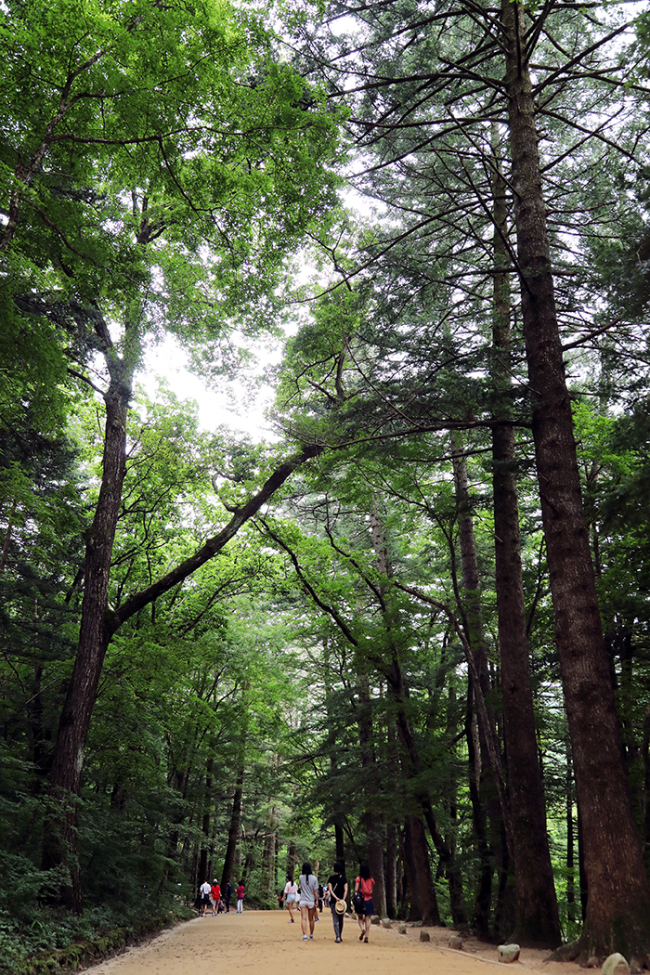[Weekender] Urban forests offer greener life in Seoul’s concrete jungle
By Kim Da-solPublished : Aug. 25, 2017 - 17:39
Seoul is probably more closely associated with stark concrete jungle than forests.
However, the city is becoming greener as local governments turn to forests to battle pollution.
Forests in urban areas work as filters for air pollutants and fine particles. According to the National Institute of Forest Science, a single tree can absorb 35.7 grams of fine dust particles in a year -- an amount that could fill an espresso cup.
A coniferous tree can absorb up to 44 grams of air pollutants, and environmentalists say such trees help raise humidity and reduce temperatures in cities.
However, the city is becoming greener as local governments turn to forests to battle pollution.
Forests in urban areas work as filters for air pollutants and fine particles. According to the National Institute of Forest Science, a single tree can absorb 35.7 grams of fine dust particles in a year -- an amount that could fill an espresso cup.
A coniferous tree can absorb up to 44 grams of air pollutants, and environmentalists say such trees help raise humidity and reduce temperatures in cities.

A study conducted by the NIFS showed that in April, when the amount of fine dust particles peaks, the level of PM 2.5 concentration hits an average 75 micrograms per cubic meter inside an urban forest, while 110 micrograms per cubic meter can be recorded near bus stops.
“The presence of a large number of plants, trees and shrubs contributes to the cleaning of the air,” said Park Chan-yeol, a researcher at NIFS.
“What is important is that the greenery inside the city significantly contributes to air purification in terms of absorbing the dust produced by urban traffic.”
Urban forests also help the city cool down.
A study by the Seoul Institute showed urban forests can decrease temperatures by as much as 7 degrees Celsius and increase humidity by up to 23 percent.
The study also observed that temperatures on tree-lined streets were an average 2.5 degrees lower, which researchers say is equivalent to operating five air conditioners for five hours in a room the size of 15 square meters.
With more citizens preferring to live near wooded areas, certain areas of Seoul have also seen property values rise sharply.
Despite increased awareness of the benefits of trees, Seoul remains far less green than other cities.
The World Health Organization’s recommended per capita urban forest area is 9.9 square meters.
London has the most with 27 square meters, followed by New York with 23 square meters. Seoul’s per capita urban forest area amounts to just 4.4 square meters.
In April, the city government mapped out a new initiative to establish more than 400 forests by 2023 to offer outdoor education programs such as “forest kindergartens,” where children living in urban areas can experience nature.
“As many citizens share the opinion that there is a lack of opportunities for them to experience nature in Seoul, we will continue to build more urban forests for families, children and senior citizens so they can enjoy the benefits of greenery without having to travel to the countryside,” said Choi Gwang-bin, a Seoul City official in charge of the green policy division.
By Kim Da-sol (ddd@heraldcorp.com)







![[Graphic News] More Koreans say they plan long-distance trips this year](http://res.heraldm.com/phpwas/restmb_idxmake.php?idx=644&simg=/content/image/2024/04/17/20240417050828_0.gif&u=)
![[KH Explains] Hyundai's full hybrid edge to pay off amid slow transition to pure EVs](http://res.heraldm.com/phpwas/restmb_idxmake.php?idx=644&simg=/content/image/2024/04/18/20240418050645_0.jpg&u=20240419100350)






![[From the Scene] Monks, Buddhists hail return of remains of Buddhas](http://res.heraldm.com/phpwas/restmb_idxmake.php?idx=652&simg=/content/image/2024/04/19/20240419050617_0.jpg&u=20240419175937)

![[KH Explains] Hyundai's full hybrid edge to pay off amid slow transition to pure EVs](http://res.heraldm.com/phpwas/restmb_idxmake.php?idx=652&simg=/content/image/2024/04/18/20240418050645_0.jpg&u=20240419100350)

![[Today’s K-pop] Illit drops debut single remix](http://res.heraldm.com/phpwas/restmb_idxmake.php?idx=642&simg=/content/image/2024/04/19/20240419050612_0.jpg&u=)